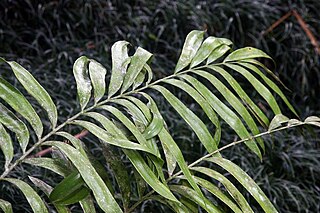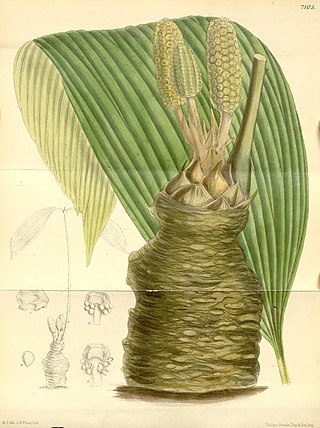See also
- Chiguanco thrush (Turdus chiguanco)
- Johnson South Reef, Chinese :赤瓜礁; pinyin :Chìguā Jiāo
Chigua may refer to:

Zamia pumila, commonly known as guáyiga or guáyara in Spanish, is a small, tough, woody cycad native to the Greater Antilles. Z. pumila was the first species described for the genus and, therefore, is the type species for the genus Zamia, the Zamia pumila species complex, and the family Zamiaceae.

The Zamiaceae are a family of cycads that are superficially palm or fern-like. They are divided into two subfamilies with eight genera and about 150 species in the tropical and subtropical regions of Africa, Australia and North and South America.

Zamia is a genus of cycad of the family Zamiaceae, native to North America from the United States throughout the West Indies, Central America, and South America as far south as Bolivia. The genus is considered to be the most ecologically and morphologically diverse of the cycads, and is estimated to have originated about 68.3 million years ago.

Encephalartos is a genus of cycad native to Africa. Several species of Encephalartos are commonly referred to as bread trees, bread palms or kaffir bread, since a bread-like starchy food can be prepared from the centre of the stem. The genus name is derived from the Greek words en (within), kephalē (head), and artos (bread), referring to the use of the pith to make food. They are, in evolutionary terms, some of the most primitive living gymnosperms.
Chigua was formerly recognized as a genus of cycads in the family Zamiaceae containing two species described in 1990. It was re-described as a single species in the genus Zamia in 2009.

Zamia acuminata is a species of plant in the family Zamiaceae which is threatened by habitat loss. It is found in Costa Rica and Panama.

Zamia amplifolia is a species of plant in the family Zamiaceae. It is endemic to the Calima River watershed of Valle del Cauca Department, Colombia.

Zamia angustifolia is a species of plant in the genus Zamia. It is found in the Bahamas, where it is threatened by habitat loss, and in Cuba, where it is abundant.

Zamia chigua is a species of plant in the family Zamiaceae. It is found in Choco Department of Colombia and of Panama. Its natural habitat is subtropical or tropical moist lowland forests.

Zamia roezlii (chigua) is a species of cycad, a palm-like pachycaulous plant in the family Zamiaceae. It is found in Colombia and the Pacific coast of Ecuador. It is named for the Czech botanist Benedikt Roezl. A single sperm cell from Zamia roezlii is about 0.4 mm in length and is visible to the unaided eye, being the world's largest plant sperm cell. Drosophila bifurca, a species of fruit fly, has sperm that are 5.8 cm long, albeit mostly coiled tail. The tree is up to 22 feet in height with fronds up to ten feet long bearing leaflets up to twenty inches long and six inches wide.

Zamia wallisii is a species of plant in the family (Zamiaceae) that is commonly known as the chigua. It is endemic to Colombia.
Johnson Reef may refer to a number of maritime features in the Union Bank / Union Reefs of the Spratly Islands:
Aulacophyllum may refer to:

Zamia erosa is a species of cycad native to the Caribbean islands of Jamaica, Cuba, and Puerto Rico, described by Orator Fuller Cook and Guy N. Collins in 1903. The species formerly known as Z. amblyphyllidia was determined in 2010 to be the same species as Z. erosa. It is listed as vulnerable by the IUCN Red List.

Zamia restrepoi is a species of cycad in the family Zamiaceae.

Zamia integrifolia, also known as coontie, is a small, tough, woody cycad native to the southeastern United States, the Bahamas, Cuba, the Cayman Islands, and Puerto Rico.
Eostangeria is a morphogenus of fossil foliage belonging to the Cycadales.
Restrepophyllum is a genus of fossil foliage attributable to the Zamiaceae. This genus is found in Early Cretaceous rocks from Argentina.